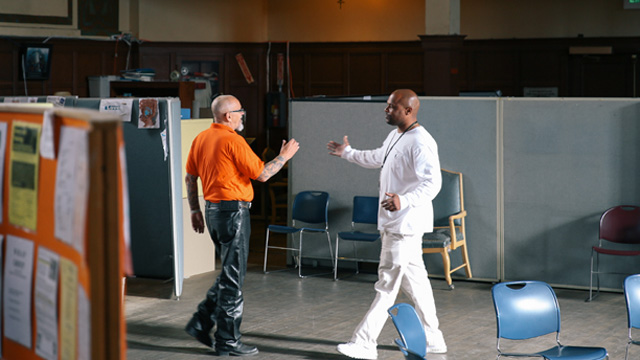This is the 12th time Wimberly has appeared before the parole board. But it's his first hearing under a new state law (SB260) requiring the parole board to weigh the age of inmates who committed their crimes as juveniles.
After nearly three hours of questions and testimony, the parole board deliberates for less than 30 minutes. They reconvene, and Parole Commissioner Marisela Montes announces the board's decision.
“We find that Mr. Wimberly does not pose an unreasonable risk of danger to society or threat to public safety and is therefore now eligible for parole,” she says.
But that's not the final word. California is one of just three states where governors can block parole decisions. And while previous California governors routinely vetoed parole for lifers, Jerry Brown is taking a very different approach — allowing 80 percent of parole recommendations to move forward.
Stanford law Professor Robert Weisberg says the change is striking.
“I mean statistically it's a very dramatic change from the Schwarzenegger administration and an unbelievable change from the Gray Davis administration,” Weisberg says.
The California Report's analysis of state parole data finds that since 2009, more than 1,700 lifers have been released in California — that's more than twice the number paroled in the previous two decades combined.
And not everyone is happy about the trend.
At a rally for crime victims' families in Sacramento recently, Susan Hamlin describes the upset caused by having to attend a parole hearing for someone who victimized her family.
“And the dread of this hearing, and fear of his possible release, set in a full year prior to the hearing,” Hamlin says.
The Capitol sidewalk is lined with posters showing photos of relatives who were murdered. Gov. Brown tells the crowd they aren't forgotten.
“When you come here and show us the pictures of real human beings who are your loved ones who were murdered, then it isn't abstract,” the governor says. “It's very real. It's very individual. It's a person.”
Afterward, I ask the governor if he ever worries about a paroled lifer committing another violent crime.
“I'm worried about a number of things,” he says, rattling off concerns like climate change and childhood hunger. “But after we catalog our worries, we have to do what our job is. And I try to do that with common sense and a certain degree of compassion.”
Asked to describe his approach toward lifer parole, Brown says simply “to follow the law and evaluate very carefully each case, which I do every week.”
When told that his record is very different from past governors, he said, "Well, I don't know what they did and whether they read the record or whether they looked at the law. The law has changed.”
Brown is referring to a 2008 decision by the California Supreme Court. It stopped blanket denials of parole based on the viciousness of a crime alone. The justices ruled that there must also be evidence that an inmate is still a threat to public safety.
Jennifer Shaffer, executive director of the state Board of Parole Hearings, says that decision changed everything.
“As you can imagine, if their crime alone could keep them from being paroled forever, then that was really not life with the possibility of parole,” Shaffer notes. “So there had to be something else.”
By following the new legal guidelines Shaffer says, Brown is saving the time and taxpayer expense of inmate appeals that result in lifers being paroled anyway.
A California Report analysis also finds that under Brown, the parole board is granting parole at a rate that's more than triple what it was five years ago.
Attorney Charles Carbone represents hundreds of lifers. He says Brown's appointees are taking a different approach.
“They're more sensitive and understanding of the rights of life inmates to receive parole,” Carbone says. “There were parole commissioners in the past who just had a philosophy, if you want to call it, where they issued blanket denials.”
But some critics, like Christine Ward with the Crime Victims Action Alliance, believe the current parole board is simply too lenient.
“It really is like playing Russian roulette,” she says. “We just hope that that one time bomb doesn't go off and create that really serious, heinous crime that will leave, not only that family devastated, but the entire state devastated. We've seen it before.”
And what kind of risk do paroled lifers present? The Stanford Criminal Justice Center examined 860 murderers paroled in California over 15 years and found that only five were returned to prison for new felonies. That works out to less than 1 percent.
The main reason, says Weisberg, is that paroled lifers are typically older. Young people, he says, are far more likely to commit violent crimes.
James Thomas can attest to that. He went to prison at the age of 17 after killing someone during a robbery in Los Angeles. He's now 47.
After being denied parole 14 times, Thomas was finally released last year — after 30 years in prison.
“Everybody makes mistakes,” Thomas says. “Some are just more costly than others. I think once a person makes that transition from one lifestyle to another, he should be or she should be able to live their life in peace and be respected for it.”
Given the rising number of lifers winning parole, the State Department of Corrections and Rehabilitation has begun new programs to help inmates prepare for life on the outside.
This story is part of our series, "Second Chance: Lifers and Parole in California."
More: Behind California?s Dramatic Increase in Lifers Freed from Prisons
More: Former Lifers Discuss Hopes, Fears After Winning Parole
